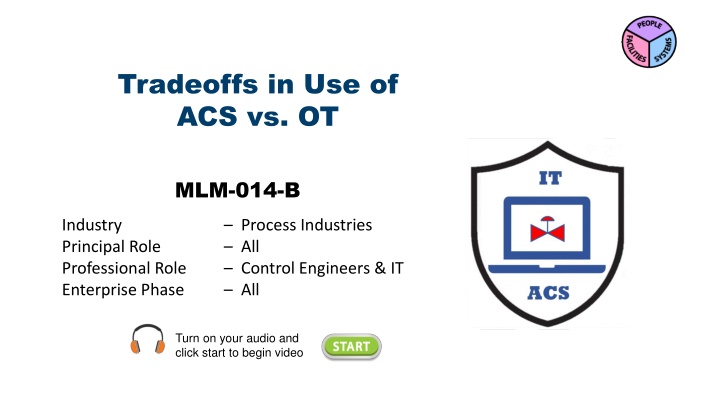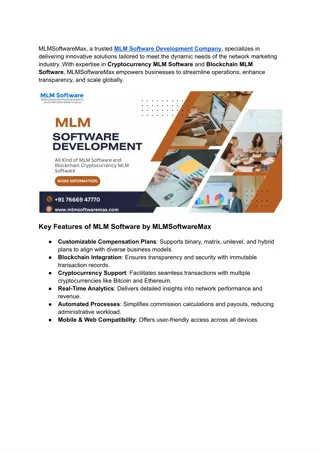
Tradeoffs in Use of ACS vs. OT in Industries
Compare the tradeoffs between Automation and Control Systems (ACS) and Operational Technology (OT) in industrial settings. Explore the formal definitions of OT and ACS, their architectural concepts, and human factors influencing their use. Discover how ACS and OT concepts differ and where they fit into enterprise architecture, highlighting their roles in different industrial environments.
Download Presentation

Please find below an Image/Link to download the presentation.
The content on the website is provided AS IS for your information and personal use only. It may not be sold, licensed, or shared on other websites without obtaining consent from the author. If you encounter any issues during the download, it is possible that the publisher has removed the file from their server.
You are allowed to download the files provided on this website for personal or commercial use, subject to the condition that they are used lawfully. All files are the property of their respective owners.
The content on the website is provided AS IS for your information and personal use only. It may not be sold, licensed, or shared on other websites without obtaining consent from the author.
E N D
Presentation Transcript
Tradeoffs in Use of ACS vs. OT MLM-014-B Industry Principal Role Professional Role Enterprise Phase Process Industries All Control Engineers & IT All Turn on your audio and click start to begin video
Clear Definition of Terms, Architectures, and Human Factors are Required To compare tradeoffs in their use, exact definitions of OT and ACS are required including: Formal definitions by bodies originating each term Architectural concepts associated with each alternative Human and organizational aspects of the use of each 2
Formal Definition of OT In 2006 Gartner coined the term Operational Technology Initially the term was applied to power utility control systems (particularly in Electrical power distribution rather than power generation). Over time the term was adopted by other industrial sectors and used in combination with IoT. A principal driver of the adoption of the term was that the nature of operational technology platforms had evolved from bespoke proprietary systems to complex software portfolios that rely on IT infrastructure. 3
Formal Definition of ACS ISA has coined the term ACS or Automaton and Control Systems defined as a collection of processes, personnel, hardware, and software that influence the safe, secure, and reliable operation of an industrial process. essentially encompassing all components involved in automating an industrial operation, including sensors, controllers, actuators, and communication networks. Initially, the term was applied to continuous process industries like refining where it was compatible with: Enterprise Integration Standards like ISA95 Networking standards like ISA100 Industrial device configuration standards like ISA108 4
How do OT and ACS Concepts Compare Neither OT or ACS definitions (above) specify an Architecture or the Professional Skills involved, so it is difficult to assess: Where they should fit in the Enterprise Architecture Who should be responsible for design, support, and maintenance Sometimes OT and ACS terms are used as synonyms; however, this may be misleading or even dangerous. Depending on the Enterprise Architecture, they may actually be opposites As a general rule, an ACS approach is better for hazardous facilities like refineries or fossil power plants, and An OT approach may be better for specialized environments like electrical distribution or renewables generation. 5
Characteristics of IT Infrastructure OT evolved for complex software portfolios that rely on IT infrastructure PRO CON Designs are modern and vendor architectures are flexible Products not intended for hazardous environments or industrial networks. Equipment is low cost (Moore s law) Equipment less reliable than ACS Rapid product development cycles Short cycles reduce product stability and increase training costs IT software failures are high (66% according to Standish annual report) Software used is modern and programmers are widely available 6
Characteristics of ACS Infrastructure ACS evolved from bespoke proprietary systems" (such as DCS, SCADA, PLCs, etc.). PRO CON ACS are designed to run dangerous and costly equipment and facilities Products are reliable, robust, and certified to engineering standards Longer development cycles improve product stability and reduce training Software is configured rather than programmed reducing software bugs and improving cybersecurity. ACS products are typically more expensive. ACS products are typically one generation behind state-of-the-art Plant personnel require training in specialized devices and networks Software configuration is less flexible than custom programming. 7
4R Performance of ACS & IT Infrastructure 4Rs Control Systems MTBF (mean time between control failures) ( months to years ) Control Networks MTBF (mean time between link failures) ( months to years ) IT Systems MTBF (mean time between application restarts) ( days to weeks ) IT Networks MTBF (mean time between link failure) RELIABILITY (Mean Time Between Failure) ( months ) REPAIRABILITY Mean Time To Repair) MTTR -time to backup switchover (milli-secs to hrs ) MTTR -time to backup switchover) ( milli-sec to secs ) Mean time between application updates ( weeks to months ) Mean time between Link failures ( days to weeks ) RESPONSE Time from poll to response ( milli-sec to secs ) Latency Time from <Enter> to response ( seconds ) Long loop Response time ( fractions of seconds ) ( milli-sec ) RESOLUTION A to D converter bits ( typically 12 bits ) Band width Floating Point number (32 or 64 bits ) Bandwidth (Points per second) ( Carrier frequency Ghz) 8
Cybersecurity of IT and ACS Infrastructure RELATIVE IMPORTANCE FOR IT AND ACS SYSTEMS AND NETWORKS 5 4 3 2 1 0 Safety Availability Integrity Confidentiality IT ACS 9
Key Take-away Messages 1. OT may be Advantageous for: 1. Sophisticated optimization 2. Interfaces to IT systems 3. Patching and updating 2. ACS may be Advantageous for: 1. Control of hazardous or costly equipment 2. Reliability and maintainability 3. Cybersecure operation 10
Key Take-away Messages 3. It is essential to clearly identify professional roles 1. IT applications are developed and supported within the IT Infrastructure 2. OT applications require skills from both ACS and IT environments including loop tuning and stability, Human Machine Interfaces, process optimization strategies, etc. 3. ACS responsibilities are clearly established including skills and tools for working in hazardous environments, equipment and controls troubleshooting, RESPONSIBILITY IT IT Specialists IT & OT Specialists Collaborate OT Control Engineers ACS 11
More Reading Related MLMs: MLM-014-A ACS, IT and OT Definitions MLM-014-C What are Cloud, IoT and IIoT Systems MLM-014-D When to use Cloud, IoT and IIoT Systems MLM-034-A Cybersecure IT and ACS Interfacing 3d Party References ISA 62443-1-1 Concepts and Models 12
Author Gary has more than 40 years of experience with enterprise integration and optimization projects, including PERA master planning and project management. As one of the initial authors of the PERA Handbook of Master Planning, he has used PERA Enterprise Architecture and Master Planning methodologies throughout his career including control and information systems for oil production, pipelines, refining and marine loading, petrochemicals, coal, gas, and oil-fired power plants, polyethylene, ammonia, explosives, paint, pulp and paper, food and beverage, and pharmaceuticals. LNG facilities included world-scale arctic, European, and US Gulf coast complexes. infrastructure facilities included Fire, Police, and Emergency Response systems for major US cities, as well as emissions reporting and trading systems for more than 100 US Power Plants, https://creativecommons.org/licenses/by-sa/4.0/ Please click here to provide feedback on this MLM. 13


